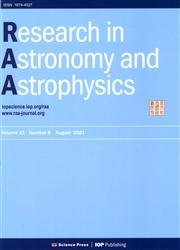广域巡天望远镜基本巡天调度
IF 2.8
4区 物理与天体物理
Q3 ASTRONOMY & ASTROPHYSICS
引用次数: 0
摘要
摘要为了提高广域巡天望远镜(WFST)的巡天效率,综合考虑冷湖站点的望远镜特点、观测条件和气象条件,制定了一套基本的巡天调度策略。天空区域被划分为矩形区域,称为“瓦片”,大小为2.577◦× 2.634◦ 略小于马赛克 ccd的焦点区域。这些瓷砖被连续地填充成与赤道平行的环形。天空背景的亮度随月相和离月距离的变化而变化,在确定可访问的调查场方面起着重要作用。大约50个相连的瓦片被分组成一个块进行观测。为了优化调查计划,我们通过考虑曝光长度、数据读出、望远镜旋转和所有相关观测条件来进行模拟。我们利用贪心算法进行调度优化。此外,我们提出了一种专用的抖动模式来覆盖CCD和马赛克CCD阵列的四个角之间的间隙,这些角位于3度视场之外。这种抖动模式有助于为最终的测量输出实现相对均匀的曝光图。本文章由计算机程序翻译,如有差异,请以英文原文为准。
Basic Survey Scheduling for the Wide Field Survey Telescope (WFST)
Abstract Aiming at improving the survey efficiency of the Wide Field Survey
Telescope (WFST), we have developed a basic scheduling strategy that takes into
account the telescope characteristics, observing conditions, and weather conditions
at the Lenghu site. The sky area is divided into rectangular regions, referred to as
‘tiles’, with a size of 2.577◦ × 2.634◦
slightly smaller than the focal area of the mosaic
CCDs. These tiles are continuously filled in annulars parallel to the equator. The
brightness of the sky background, which varies with the moon phase and distance
from the moon, plays a significant role in determining the accessible survey fields.
Approximately 50 connected tiles are grouped into one block for observation. To opti mize the survey schedule, we perform simulations by taking into account the length of
exposures, data readout, telescope slewing, and all relevant observing conditions. We
utilize the Greedy Algorithm for scheduling optimization. Additionally, we propose
a dedicated dithering pattern to cover the gaps between CCDs and the four corners
of the mosaic CCD array, which are located outside of the 3-degree field of view.
This dithering pattern helps to achieve relatively uniform exposure maps for the final
survey outputs.
求助全文
通过发布文献求助,成功后即可免费获取论文全文。
去求助
来源期刊

Research in Astronomy and Astrophysics
地学天文-天文与天体物理
CiteScore
3.20
自引率
16.70%
发文量
2599
审稿时长
6.0 months
期刊介绍:
Research in Astronomy and Astrophysics (RAA) is an international journal publishing original research papers and reviews across all branches of astronomy and astrophysics, with a particular interest in the following topics:
-large-scale structure of universe formation and evolution of galaxies-
high-energy and cataclysmic processes in astrophysics-
formation and evolution of stars-
astrogeodynamics-
solar magnetic activity and heliogeospace environments-
dynamics of celestial bodies in the solar system and artificial bodies-
space observation and exploration-
new astronomical techniques and methods
 求助内容:
求助内容: 应助结果提醒方式:
应助结果提醒方式:


